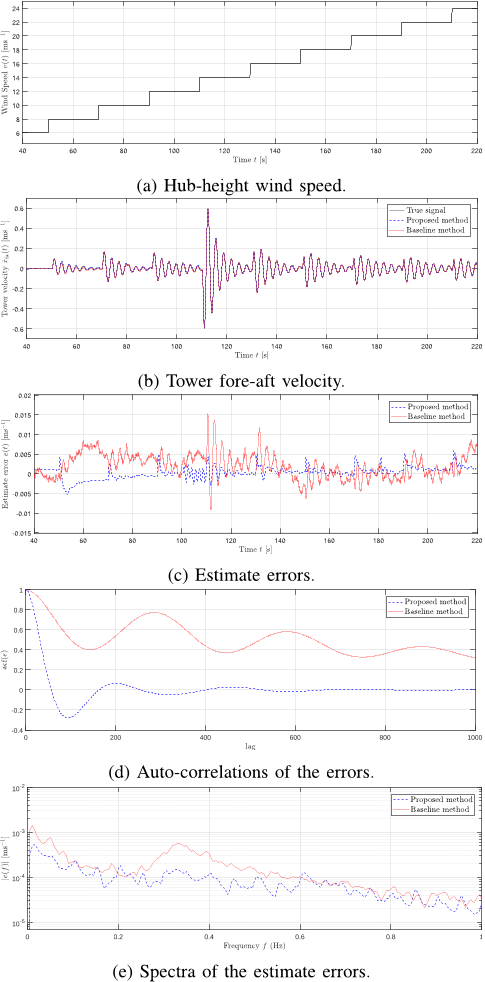




read more










Owing to variable blade geometry, the wind-induced forces are not uniformly distributed on the blades and to model such forces, blade element/momentum theory is adopted [13], where the blade is discretised into small elements.
The key benefit of the individual-pitch-based design is that it is decoupled from the existing CPC loop, owing to the inherent properties of the Coleman transforms.
The key challenge is to separate the existing IPC loop and the tower damping control loop, which is particularly important since the tower estimate is also dependent upon the blade load measurements.
The contributions of this paper lay in the extraction of useful additional information from existing blade load sensors and7 100 105 110 115 120 125 130Time t [s]161718192021W in d S p ee d v (t ) [ms− 1 ](a) Hub-height wind speed.
The following heuristic switching policy was employed to overcome the transition between wind conditions:ẋfa(t) = ∑κρκ(t)ẋfa,κ(t), ∑κρκ(t) = 1, (14)6where κ ∈ {1, 2} is the index of observers designed in the below-rated and above-rated wind conditions, whilst ρκ ∈ R denotes the weighting on the tower estimate of the κ-th estimator.
Rnd is defined as follows:ξ̇w(t) = Awξw(t) +Bww(t), dcm(t) = Cwξw(t), (6)where the system matrices {Aw, Bw, Cw} are determined by fitting the spectra of the model output to the known spectra of the wind speed disturbances.
This work implicitly assumes the tower is a prismatic beam so that the ratio between rotation and displacement is 23h , where h ∈ R is the height of the tower [3].
The nonlinear aerodynamic forcing functions on the blade and tower are typically linearised around the operating wind conditions to obtain the perturbation forces, f̃M (θ̃i, ṽi) : R × R → R and f̃x(θ̃col, ṽcol) : R × R → R, defined as follows:f̃M (θ̃i, ṽi) = dfMdθ∣ ∣ ∣ ∣θ∗,v∗ θ̃i(t) +dfMdv∣ ∣ ∣ ∣θ∗,v∗ ṽi,(t), (1c)f̃x(θ̃col, ṽcol) = dfxdθ∣ ∣ ∣ ∣θ∗,v∗ θ̃col(t) +dfx dv∣ ∣ ∣ ∣θ∗,v∗ ṽcol(t), (1d)where dfM dθ , dfx dθ ∈ R and dfM dv , dfx dv ∈ R are the variations of the forcing with respect to the pitch angle and apparent wind speed.
Theorem 3.1: Assuming a fixed rotor speed and Coleman transformations (4), the linear time-varying system (3) can be transformed into the following LTI form:ξ̇(t) = Aξξ(t) +Bξucm(t) +Bξddcm(t),ycm(t) = Cξξ(t), (5)where ycm(t) = [M̃col(t), M̃tilt(t), M̃yaw(t)]
The damping ratio of the blade and tower are ζb, ζt ∈ R and ωb, ωt ∈ R are the respective natural frequencies of the blade and tower.
The azimuthal angle of each blade is defined as [φ1(t), φ2(t), φ3(t)] := [φ(t), φ(t) + 2π 3 , φ(t) + 4π 3 ], where φ(t) is the angle of the first blade from the horizontal yaw axis with respect to the clockwise direction.
In addition, in Figure 6d, it is clearly seen that the error auto-correlation of the proposed method was closer to zero, suggesting its residual was almost white noise.
Since the focus of this work is on the blade disturbance induced by the wind, the effect of the wind perturbations upon the blade, ṽi(t) in (1), can be approximated by averaging the apparent wind speed perturbations ṽi,l(t) along the blade, as follows:ṽi(t) ≈ 1L∑lṽi,l(t),= ṽ∞,i(t)− ˙̃xfa(t) + kϕ ˙̃xfa(t) sin ( φi(t) ) .
Compared to the collective pitch-based design, the individual-pitch-controller imposed slightly larger tilt and yaw loads at the tower resonant frequency, upon the non-rotating turbine structure.